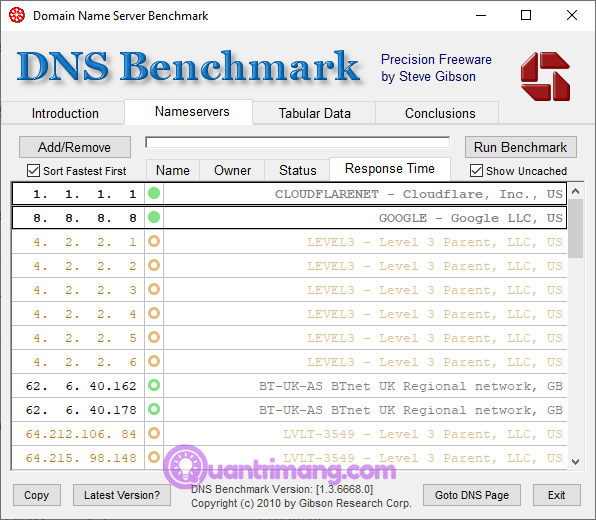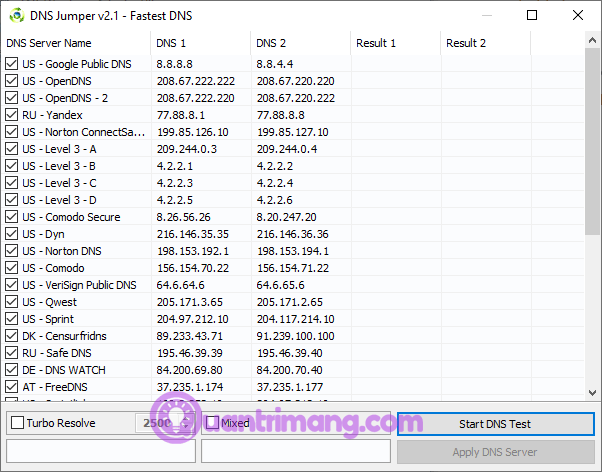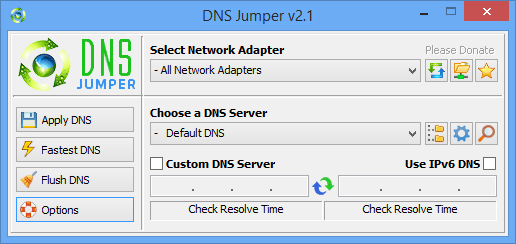Similarly, your Wi-Fi router has a DNS cache as well. This is why most people recommend rebooting the router as a troubleshooting step, as it flushes the DNS cache as well. If your Mac is running an older version of macOS, you might want to learn how to reset DNS cache in macOS High Sierra, or flushing the DNS cache in macOS Sierra and so on. Download DNS Jumper, and extract it to any location on your hard drive. It's a portable application, so there's no need to install it—just start it up. If you know what DNS server you want to use. You can reset and clear DNS cache in macOS Big Sur to fix most DNS issues that you might be facing. The method mentioned in the article works for Mac OS Big Sur 15, and even on macOS Big Sur. If you face any issues with the commands I mentioned, feel free to let me know in the comments section down below.
To list the entries of DNS cache in OSX 10.11.6, I tried dscacheutil -statistics but that didn't work. I tried this under Mac OS X Sierra 10.12.2 and it doesn't. OS X is handling DNS differently compared to other OS. The DNS list is not working as you might think, you entered two DNS Servers, your local DNS server 10.20.1.3 and Google DNS 8.8.8.8 for public, but this is not how OS X will deal with your DNS list entries. Here is a short snipped from the OS X 'resolver' documentation.
DNS Jumper (DNS stands for domain name system), instantly changes website links that are comprehensible by humans in code lines readable only by computers. The process consists in replacing standard names in the underlying IP addresses of a specific site/ link with a click.
DNS Jumper proves to be useful in accessing for example blocked websites, preventing children from watching inappropriate web content that is suitable for adults only, securing web-surfing through the use of dedicated DNS servers. Moreover, DNS Jumper increases Internet speed by jumping to a faster DNS and offers plenty other innovative features, like the option to create personal DNS groups.
This software comes after a dozen of improvements versus previous version in algorithmic calculations, interface usability, the introduction of country aimed DNS’s, automatic cleaning of DNS cache, voice alert option, mixing DNS’s for speed boost etc.
Changing DNS settings becomes a child task with DNS Jumper. All you have to do is select one DNS server from a given list and apply changes. This process is reversible. Anytime you want, the ‘Quick Configuration’ tab helps you revert DNS settings or going back to the ISP’s default DNS.
DNS Jumper is available for all distributions of Windows, including Windows 10 (x86 & x64) and comes with a rich language package, which further increases the accessibility already offered by the intuitive and straightforward interface.

Pros
- Does not need installation
- Improves your computer security
- Increases browsing speed
- Small size ( 500 KB )
- Easy to use
Cons
- Not available for Mac OS X
Conclusion
DNS Jumper is the perfect freeware solution created to speed up internet access, secure daily Web surfing both for you and for your children, and regain access to until now blocked websites.
Download it from here (DnsJumper.zip – 520KB).
An alternative download location here: https://www.filecroco.com/download-dns-jumper/
DNS is an integral service to most modern networks. The Domain Name System, or DNS is comprised of hierarchical and decentralized Domain Name Servers, or DNS Servers. This is how we connect to computers and the websites that reside on computers by their names, rather than having to memorize the IP addresses of every single computer out there. So you get to type https://krypted.com/ and come to my website instead of typing the IP address. Or more likely, Facebook.com, but just because my website is older, I’m not mad about that. No really… So you have a macOS Server and you need to take your DNS records out of it and move them to another solution. Luckily, DNS on any operating system is one of the easiest to manage. So let’s start by dumping all of our zone records and settings using the dnsconfig command:
So you have a macOS Server and you need to take your DNS records out of it and move them to another solution. Luckily, DNS on any operating system is one of the easiest to manage. So let’s start by dumping all of our zone records and settings using the dnsconfig command:
/Applications/Server.app/Contents/ServerRoot/System/Library/PrivateFrameworks/DNSManager.framework/dnsconfig list
ACLs:
com.apple.ServerAdmin.DNS.public
Options:
directory: /Library/Server/named
allow-recursion: com.apple.ServerAdmin.DNS.public
allow-transfer: none
forwarders: 8.8.8.8 4.4.4.4
Views:
com.apple.ServerAdmin.DNS.public
Zones:
test.com
Options:
allow-transfer: none
allow-update: none
Resource Recs:
testalias.test.com (CNAME)
test.com (SOA)
test.com (NS)
test.com (MX)
test.test.com (A)
Resource Recs:
no resource recs
0.0.127.in-addr.arpa
Options:
allow-update: none
Resource Recs:
0.0.127.in-addr.arpa (SOA)
0.0.127.in-addr.arpa (NS)
1.0.0.127.in-addr.arpa (PTR)
0.0.10.in-addr.arpa
Options:
allow-transfer: none
allow-update: none
Resource Recs:
1.0.0.10.in-addr.arpa (PTR)
0.0.10.in-addr.arpa (SOA)
0.0.10.in-addr.arpa (NS)
cat /Library/Server/named/db.test.com
test.com.10800 IN SOAtest.com. admin.test.com. (
2018033001
3600
900
1209600
86400)
10800 IN NStest.test.com.
10800 IN MX0 test.test.com.
test.test.com.10800 IN A10.0.0.1
testalias.test.com.10800 IN CNAMEtest.test.com.
Dns Jumper Mac Os X 10.8

- Primary Zone: The DNS “Domain”. For example, https://krypted.com/ would likely have a primary zone of krypted.com.
- Machine Record: An A record for a computer, or a record that tells DNS to resolve whatever name is indicated in the “machine” record to an IP address, whether the IP address is reachable or not.
- Name Server: NS record, indicates the authoritative DNS server for each zone. If you only have one DNS server then this should be the server itself.
- Reverse Zone: Zone that maps each name that IP addresses within the zone answer with. Reverse Zones are comprised of Reverse Mappings and each octal change in an IP scheme that has records mapped represents a new Reverse Zone.
- Reverse Mapping: PTR record, or a record that indicates the name that should respond for a given IP address. These are automatically created for the first IP address listed in a Machine Record.
- Alias Record: A CNAME, or a name that points to another name.
- Service Record: Records that can hold special types of data that describe where to look for services for a given zone. For example, iCal can leverage service records so that users can just type the username and password during the setup process.
- Mail Exchanger Record (aka MX record): Mail Exchanger, points to the IP address of the mail server for a given domain (aka Primary or Secondary Zone).
- Secondary Zone: A read only copy of a zone that is copied from the server where it’s a Primary Zone when created and routinely through what is known as a Zone Transfer.
- allow-transfer Takes one or more address match list entry. Address match list entries consist of any of these forms: IP addresses, Subnets or Keywords.
- allow-recursion Takes one or more address match list entry.
- allow-update Takes one or more address match list entry.
- allow-query Takes one or more address match list entry.
- allow-query-cache Takes one or more address match list entry.
- forwarders Takes one or more IP addresses, e.g. 10.1.1.1
- directory Takes a directory path
- tkey-gssapi-credential Takes a kerberos service principal
- tkey-domain Takes a kerberos realm
- update-policy Takes one complete update-policy entry where you can grant or deny various matched objects and specify the dentity of the user/machine that is allowed/disallowed to update.. You can also identify match-type (Type of match to be used in evaulating the entry) and match-name (Name used to match) as well as rr-types (Resource record types that can be updated)
serveradmin settings dnsDns Jumper Mac Os X 10.10
And the output would look something like this:Dns Jumper Mac Os X 10.7
dns:acls:_array_index:0:name = “com.apple.ServerAdmin.DNS.public”
dns:acls:_array_index:0:addressMatchList:_array_index:0 = “localhost”
dns:acls:_array_index:0:addressMatchList:_array_index:1 = “localnets”
dns:forwarders:_array_index:0 = “8.8.8.8”
dns:forwarders:_array_index:1 = “4.4.4.4”
dns:views:_array_id:com.apple.ServerAdmin.DNS.public:reverseZones:_array_id:0.0.10.in-addr.arpa:aliases = _empty_array
dns:views:_array_id:com.apple.ServerAdmin.DNS.public:reverseZones:_array_id:0.0.10.in-addr.arpa:expire = 1209600
dns:views:_array_id:com.apple.ServerAdmin.DNS.public:reverseZones:_array_id:0.0.10.in-addr.arpa:serial = 2018033001
dns:views:_array_id:com.apple.ServerAdmin.DNS.public:reverseZones:_array_id:0.0.10.in-addr.arpa:allow-update = no
dns:views:_array_id:com.apple.ServerAdmin.DNS.public:reverseZones:_array_id:0.0.10.in-addr.arpa:adminEmail = “admin@0.0.10.in-addr.arpa”
dns:views:_array_id:com.apple.ServerAdmin.DNS.public:reverseZones:_array_id:0.0.10.in-addr.arpa:machines = _empty_array
dns:views:_array_id:com.apple.ServerAdmin.DNS.public:reverseZones:_array_id:0.0.10.in-addr.arpa:nameservers:_array_index:0:name = “0.0.10.in-addr.arpa”
dns:views:_array_id:com.apple.ServerAdmin.DNS.public:reverseZones:_array_id:0.0.10.in-addr.arpa:nameservers:_array_index:0:value = “test.test.com.”
dns:views:_array_id:com.apple.ServerAdmin.DNS.public:reverseZones:_array_id:0.0.10.in-addr.arpa:refresh = 3600
dns:views:_array_id:com.apple.ServerAdmin.DNS.public:reverseZones:_array_id:0.0.10.in-addr.arpa:mailExchangers = _empty_array
dns:views:_array_id:com.apple.ServerAdmin.DNS.public:reverseZones:_array_id:0.0.10.in-addr.arpa:reverseMappings:_array_index:0:value = “test.test.com.”
dns:views:_array_id:com.apple.ServerAdmin.DNS.public:reverseZones:_array_id:0.0.10.in-addr.arpa:reverseMappings:_array_index:0:ipAddress = “10.0.0.1”
dns:views:_array_id:com.apple.ServerAdmin.DNS.public:reverseZones:_array_id:0.0.10.in-addr.arpa:retry = 900
dns:views:_array_id:com.apple.ServerAdmin.DNS.public:reverseZones:_array_id:0.0.10.in-addr.arpa:timeToLive = 86400
dns:views:_array_id:com.apple.ServerAdmin.DNS.public:reverseZones:_array_id:0.0.10.in-addr.arpa:serviceRecords = _empty_array
dns:views:_array_id:com.apple.ServerAdmin.DNS.public:reverseZones:_array_id:0.0.10.in-addr.arpa:name = “0.0.10.in-addr.arpa”
dns:views:_array_id:com.apple.ServerAdmin.DNS.public:reverseZones:_array_id:0.0.10.in-addr.arpa:allowZoneTransfer = no
dns:views:_array_id:com.apple.ServerAdmin.DNS.public:primaryZones:_array_id:test.com:aliases:_array_index:0:name = “testalias.test.com.”
dns:views:_array_id:com.apple.ServerAdmin.DNS.public:primaryZones:_array_id:test.com:aliases:_array_index:0:value = “test.test.com.”
dns:views:_array_id:com.apple.ServerAdmin.DNS.public:primaryZones:_array_id:test.com:expire = 1209600
dns:views:_array_id:com.apple.ServerAdmin.DNS.public:primaryZones:_array_id:test.com:serial = 2018033001
dns:views:_array_id:com.apple.ServerAdmin.DNS.public:primaryZones:_array_id:test.com:allow-update = no
dns:views:_array_id:com.apple.ServerAdmin.DNS.public:primaryZones:_array_id:test.com:adminEmail = “admin@test.com”
dns:views:_array_id:com.apple.ServerAdmin.DNS.public:primaryZones:_array_id:test.com:machines:_array_index:0:name = “test.test.com.”
dns:views:_array_id:com.apple.ServerAdmin.DNS.public:primaryZones:_array_id:test.com:machines:_array_index:0:ipAddresses:_array_index:0:ipAddress = “10.0.0.1”
dns:views:_array_id:com.apple.ServerAdmin.DNS.public:primaryZones:_array_id:test.com:nameservers:_array_index:0:name = “test.com”
dns:views:_array_id:com.apple.ServerAdmin.DNS.public:primaryZones:_array_id:test.com:nameservers:_array_index:0:value = “test.test.com.”
dns:views:_array_id:com.apple.ServerAdmin.DNS.public:primaryZones:_array_id:test.com:refresh = 3600
dns:views:_array_id:com.apple.ServerAdmin.DNS.public:primaryZones:_array_id:test.com:mailExchangers:_array_index:0:address = “test.test.com.”
dns:views:_array_id:com.apple.ServerAdmin.DNS.public:primaryZones:_array_id:test.com:mailExchangers:_array_index:0:priority = 0
dns:views:_array_id:com.apple.ServerAdmin.DNS.public:primaryZones:_array_id:test.com:reverseMappings = _empty_array
dns:views:_array_id:com.apple.ServerAdmin.DNS.public:primaryZones:_array_id:test.com:retry = 900
dns:views:_array_id:com.apple.ServerAdmin.DNS.public:primaryZones:_array_id:test.com:timeToLive = 86400
dns:views:_array_id:com.apple.ServerAdmin.DNS.public:primaryZones:_array_id:test.com:serviceRecords = _empty_array
dns:views:_array_id:com.apple.ServerAdmin.DNS.public:primaryZones:_array_id:test.com:name = “test.com”
dns:views:_array_id:com.apple.ServerAdmin.DNS.public:primaryZones:_array_id:test.com:allowZoneTransfer = no
dns:views:_array_id:com.apple.ServerAdmin.DNS.public:name = “com.apple.ServerAdmin.DNS.public”
dns:views:_array_id:com.apple.ServerAdmin.DNS.public:secondaryZones = _empty_array
Dns Jumper Mac Os X 10.13
sudo serveradmin settings dns > test.dns
